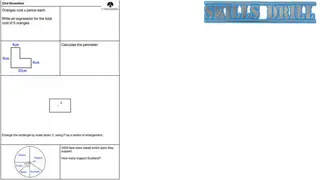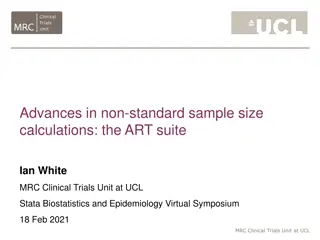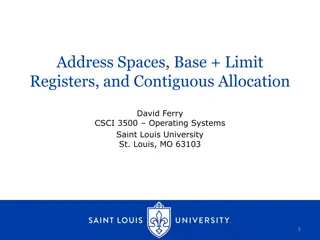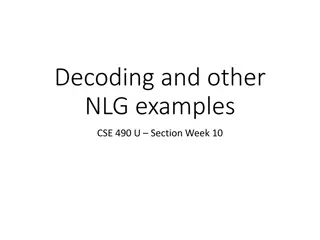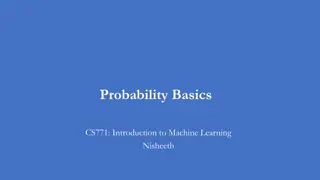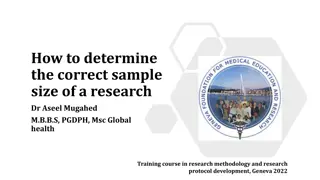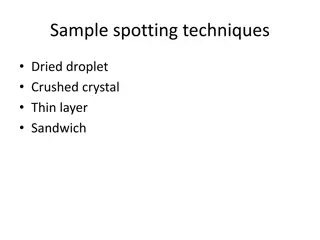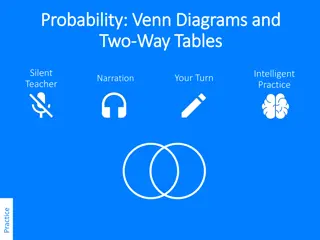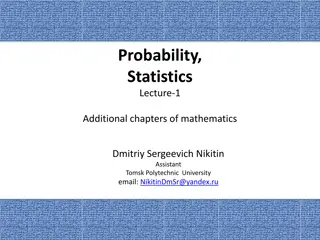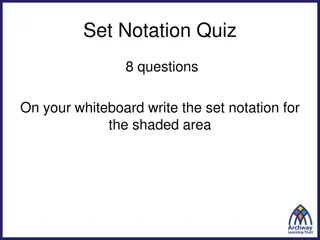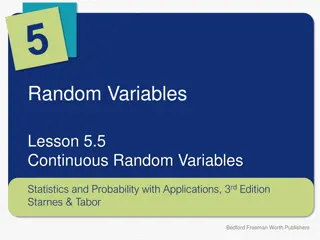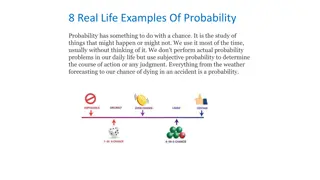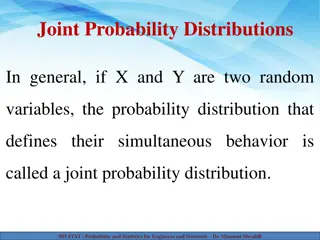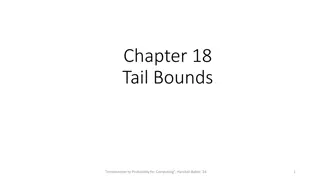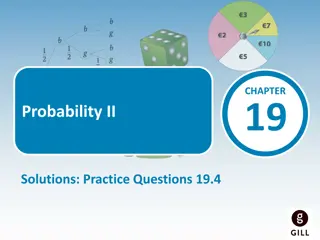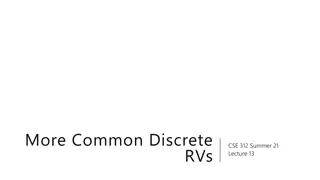Introduction to Probability and Sample Spaces in CSE 312 Lecture
Today's lecture introduced the concept of probability and its applications in quantifying uncertainty. The session covered foundational processes like flipping a coin, rolling a die, and shuffling cards to demonstrate how to calculate probabilities. Important terms such as sample space and events were explained, along with examples to illustrate their significance in probability theory.
Download Presentation

Please find below an Image/Link to download the presentation.
The content on the website is provided AS IS for your information and personal use only. It may not be sold, licensed, or shared on other websites without obtaining consent from the author. Download presentation by click this link. If you encounter any issues during the download, it is possible that the publisher has removed the file from their server.
E N D
Presentation Transcript
Probability CSE 312 Summer 21 Lecture 4
Announcements Office Hours are all up! Please check the calendar on the course staff webpage. Problem Set 1 is due this Thursday. We will also release the details of the Review Summaries assignment soon. It will be due at the end of next week.
Today So far we ve done a lot of counting. Starting today, we get to calculate probabilities! Mostly notation and vocabulary today.
Probability Probability is a way of quantifying When more than one outcome is possible, quantifying our uncertainty. To have real-world examples, we ll need to start with some foundational processes that we re going to assert exist We can flip a coin, and each face is equally likely to come up We can roll a die, and every number is equally likely to come up We can shuffle a deck of cards so that every ordering is equally likely.
Probability Line Rolling a number less than 7 on a fair die Rolling a seven on a fair die Choosing a green ball Getting Heads on a fair coin toss Choosing a red ball Impossible event 0% Even Chance 50% Likely event > 50%; <100% Unlikely event > 0%; < 50% Certain event 100%
Sample Space Sample Space A sample space is the set of all possible outcomes of an experiment. Examples: For a single coin flip: = ?,? For a series of two coin flips: = ??,??,??,?? For rolling a (normal) die: = 1,2,3,4,5,6
Events Event An event ? is a subset of possible outcomes (i.e. a subset of ?) Examples: Getting a head in a single coin toss: ? = ? Getting at least one head in two coin tosses: ? = ??,??,?? Getting an even number on a die-roll: ? = 2,4,6 Getting a number less than 5 on a die-roll: ? = 1,2,3,4
Examples D2=1 D2=1 D2=2 D2=2 D2=3 D2=3 D2=4 D2=4 I roll a blue 4-sided die and a red 4-sided die. D1=1 D1=1 (1,1) (1,2) (1,3) (1,4) The table contains the sample space. D1=2 D1=2 (2,1) (2,2) (2,3) (2,4) D1=3 D1=3 (3,1) (3,2) (3,3) (3,4) The event the sum of the dice is even is in gold The event the blue die is 1 is in purple D1=4 D1=4 (4,1) (4,2) (4,3) (4,4)
Probability Probability A probability is a number between 0 and 1 describing how likely a particular outcome is. We will define a function : 0,1 i.e., takes an element of as input and outputs the probability of the outcome which will always be between 0 and 1 (both inclusive). We will also use Pr ? ,?(?) as notation.
Example Imagine we toss one coin. Our sample space = {?,?} What do you want to be?
Example Imagine we toss one coin. Our sample space = {?,?} What do you want to be? It depends on what we want to model If the coin is fair ? = ? =1 But we also might have a biased coin: ? = .85, ? = 0.15. 2.
Probability Space Probability Space A (discrete) probability space is a pair (?, ) where: ? is the sample space :? [?,?] is the probability measure. satisfies: ? ? for all ? ? ? (?) = ? If ?,? ? and ? ? = then ? ? = ? + (?)
Probability Space Flip a fair coin and roll a fair 6-sided die. = ?,? 1,2,3,4,5,6 1 12 for every ? ? = Is this a valid probability space? takes in elements of and outputs numbers between 0 and 1. ? ? = 1
Measure = ?,? {1,2,3,4,5,6} 1 12 for every ? ? = So what s the probability of seeing a heads? Seeing heads isn t an element of the sample space! Define ? = ? E (?)
Probability Space Probability Space A (discrete) probability space is a pair (?, ) where: ? is the sample space :? [?,?] is the probability measure. satisfies: ? ? for all ? ? ? (?) = ? If ?,? ? and ? ? = then ? ? = ? + (?)
Uniform Probability Space The most common probability measure is the uniform probability measure. In the uniform probability measure, for every outcome ? 1 ? = | | Therefore, for every event ? ? =|?| | |
Activity! Let your sample space be all possible outcomes of a sequence of 100 coin tosses. Assign the uniform measure to this sample space. What is the probability of the event, ?, there are exactly 50 heads ? A. 2100 B. 101 C. 2 D. 250 E. There is not enough information in this problem. 100 50 1 1 1 Fill out the Poll Everywhere for Kushal to adjust his explanation Go to pollev.com/cse312su21
Mutually Exclusive Events Two events ?,? are mutually exclusive if they cannot happen simultaneously. In notation, ? ? = i.e., they are disjoint subsets of the sample space For example, if = ?,? 1,2,3,4,5,6 ?1= ? ? ???? ???? ?? ???? ?2= ? ? ???? ???? ?? ????? ?3= ? ? ??? ? ???? ?? ???? ?????? ?1 and ?2 are mutually exclusive ?1 and ?3 are not mutually exclusive
Axioms and Consequences We wrote down 3 requirements (axioms) on probability measures ? 0 for all ? (non-negativity) ? (?) = 1 (normalization) If ? and ? are mutually exclusive, then ? ? = ? + (?) (countable additivity) These lead quickly to these three corollaries ? = 1 (?) (complementation) If ? ?, then ? (?) (monotonicity) ? ? = ? + ? (? ?) (inclusion-exclusion)
More Examples! Suppose you roll two dice. Each die is fair and they don t affect each other. What is the probability of both dice being even? What is your sample space? What is your probability measure ? What is your event? What is the probability?
More Examples! Suppose you roll two dice. Each die is fair and they don t affect each other. What is the probability of both dice being even? What is your sample space? 1,2,3,4,5,6 {1,2,3,4,5,6} What is your probability measure ? ? = 1/36 for all ? What is your event? 2,4,6 {2,4,6} What is the probability? 32 62
More Examples! Suppose you roll two dice. Each die is fair and they don t affect each other. What is the probability of both dice being even? What if we can t tell the dice apart and always put the dice in increasing order by value. What is your sample space? { 1,1 , 1,2 , 1,3 , 1,4 , 1,5 , 1,6 , 2,2 , 2,3 , 2,4 , 2,5 ,(2,6) 3,3 , 3,4 , 3,5 , 3,6 , 4,4 , 4,5 , 4,6 , 5,5 , 5,6 ,(6,6)} What is your probability measure ? (?,?) = 2/36 if ? ?, ?,? = 1/36 What is your event? { 2,2 , 4,4 , 6,6 , 2,4 , 2,6 , 4,6 } What is the probability? 3 36+ 3 1 2 36= 9 36
Takeaways There is often more than one sample space possible! But one is probably easier than the others. Finding a sample space that will make the uniform measure correct will probably make finding the probabilities easier to calculate.
Another Example Suppose you shuffle a deck of cards so any arrangement is equally likely. What is the probability that the top two cards have the same value? Sample Space Probability Measure Event Probability
Another Example Suppose you shuffle a deck of cards so any arrangement is equally likely. What is the probability that the top two cards have the same value? Sample Space: { ?,? :? and ? are different cards } Probability Measure: uniform measure ? = Event: all pairs with equal values Probability: 13 ? 4,2 52 51 1 52 51
Another Example Suppose you shuffle a deck of cards so any arrangement is equally likely. What is the probability that the top two cards have the same value? Sample Space: Set of all orderings of all 52 cards Probability Measure: uniform measure ? = Event: all lists that start with two cards of the same value Probability: 13 ? 4,2 50! 52! 1 52!
Takeaway There s often information you don t need in your sample space. It won t give you the wrong answer. But it sometimes makes for extra work/a harder counting problem, Good indication: you cancelled A LOT of stuff that was common in the numerator and denominator.
Balls and Urns You have an urn* with two red balls and two green balls inside. Take out two of the balls replacing the first ball after you take it out. What s the probability of drawing out both red balls? Sequential process: 1 2 probability of the first being red 1 2 probability of the second being red. * An urn is a vase




















